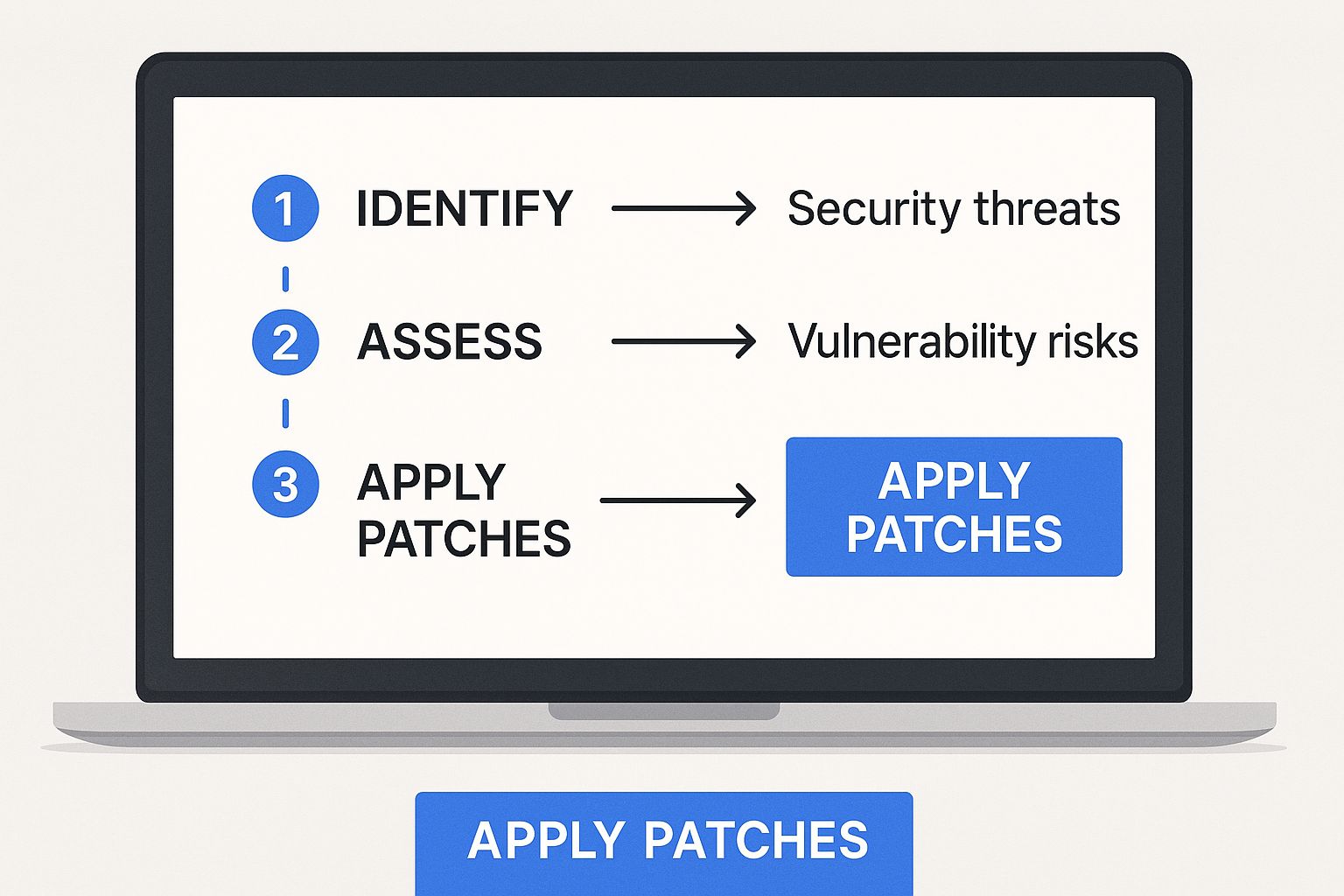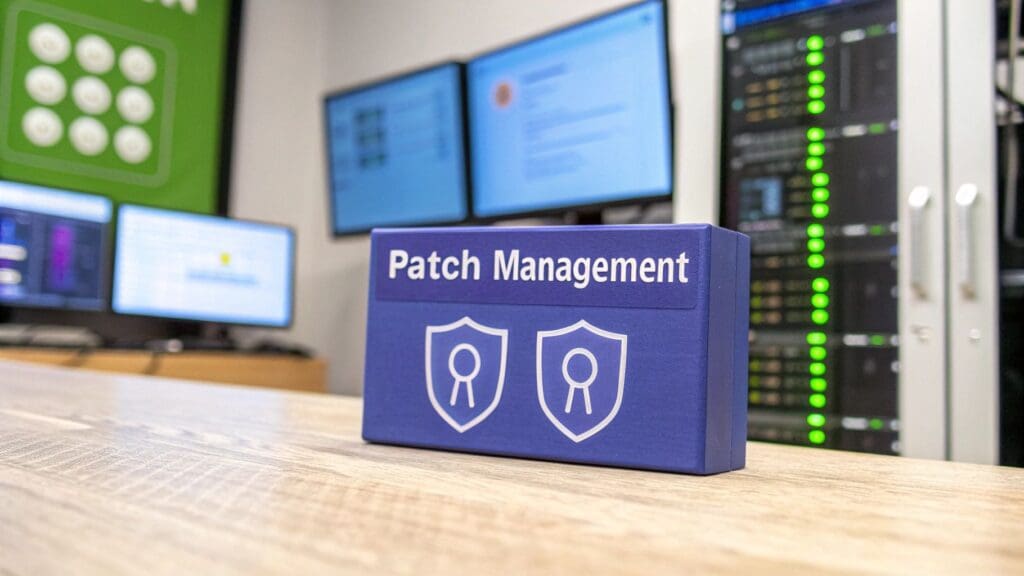Let’s start with the basics. In simple terms, patch management is the organised process of identifying, testing, and applying software updates-or ‘patches’-to your business's computer systems. It’s a foundational IT security practice that fixes vulnerabilities, sorts out annoying bugs, and sometimes adds new features to keep everything running smoothly and securely.
Understanding the Fortress of Your Systems

Think of your business's software and operating systems like a newly built fortress. At first, it seems completely impenetrable. But over time, attackers and security researchers find small cracks and weaknesses-vulnerabilities-that they can exploit to break in.
Patch management is the ongoing work of finding and sealing those cracks before someone else does. It’s much more than just clicking 'update' when a notification pops up. It's a structured, methodical approach to protecting your technology from known threats. Ignoring it is like leaving a side door of your fortress wide open for any passing thief.
Why Is It So Important?
The urgency behind patching comes down to a simple reality: the moment a software vendor releases a fix, the vulnerability it addresses becomes public knowledge. That means cybercriminals immediately start scanning for businesses that haven't applied the update yet. An unpatched system isn't just a risk; it's a target.
The UK's Cyber Security Breaches Survey revealed that a staggering 43% of UK businesses experienced a cyber breach or attack, highlighting just how widespread these risks are. It shows that a huge number of companies are still vulnerable to threats that are entirely preventable.
This proactive defence is absolutely crucial. A solid patching routine helps prevent:
- Data Breaches: Closing the very entry points attackers use to steal sensitive client data or your own company information.
- Ransomware Attacks: Many ransomware strains get their foothold by exploiting well-known software flaws to encrypt files and bring your operations to a halt.
- System Downtime: Patches often fix stability issues and bugs that could otherwise cause your most critical applications to crash at the worst possible moment.
A strong patch management strategy is not just an IT task-it's a core business function. It directly prevents the types of attacks that most frequently hit unprepared businesses, safeguarding your reputation and continuity.
How Updates Are Delivered
To really get your head around patch management, it helps to know how these updates actually arrive. For devices like mobile phones and the growing number of Internet of Things (IoT) gadgets, a common method is Over-the-Air (OTA) delivery. You can learn more about this process by reading this helpful resource on What Is OTA Update? How It Works and Why It Matters.
Ultimately, a reliable patch management plan ensures your systems are resilient and ready for whatever threats come next. This proactive stance is a key part of a much wider security framework, and it's closely related to preparing for the worst-case scenarios.
To see how patching fits into that bigger picture, you can explore our guide on https://infrazen.tech/what-is-a-disaster-recovery/.
The Core Patch Management Process Step by Step
A solid patching strategy isn’t a chaotic, random scramble-it’s a repeatable, organised cycle. When you approach it methodically, patch management stops being a stressful chore and becomes a reliable security function. Think of it like a vehicle recall process; every stage is logical and absolutely necessary for safety and performance.
This structured approach ensures nothing gets missed, turning what could be a complex mess into a manageable workflow. Each step builds on the last, creating a strong chain of defence against cyber threats.
Stage 1: Inventory and Discovery
The first step is always inventory. It’s simple: you can’t protect what you don’t know you have. This stage is all about identifying and cataloguing every single piece of hardware and software connected to your network. We’re talking servers, laptops, desktops, mobile devices, and even routers.
This initial audit creates a complete map of your technology assets. It’s the foundation for your entire patch management process, making sure no device is accidentally left unpatched and vulnerable.
Stage 2: Scanning and Identification
Once you know what you’ve got, the next step is to scan those assets for missing patches or known vulnerabilities. Specialised tools get to work, comparing the software versions running on your systems against a database of the latest releases and security updates from vendors like Microsoft, Apple, and Adobe.
This stage is like a diagnostic check-up, pinpointing exactly which systems need attention. It gives you a clear picture of your current security posture and highlights the specific weak spots that need fixing.
The infographic below shows how a security dashboard can help visualise this process, making it much easier to see what needs to be actioned.

This kind of visual report lets IT teams quickly identify and prioritise the most critical updates, so they can move on to the next stage without delay.
Stage 3: Acquisition, Testing, and Deployment
With a clear list of required patches, the process moves into its action phase. This involves three key activities that usually happen in quick succession:
- Acquisition: This is where you download the necessary patches directly from the official software vendors. It’s absolutely vital to only source patches from trusted providers to avoid accidentally installing malicious software.
- Testing: Before you roll out a patch across the entire business, you must test it in a controlled environment. This step ensures the update doesn’t create unexpected conflicts with other critical software, like your project management tools or creative applications.
- Deployment: After a successful test, the patches are scheduled and deployed to all the relevant devices. This is often automated and planned for outside of peak working hours to minimise any disruption to your team’s creative workflows.
A common mistake is skipping the testing stage to save time. This can backfire spectacularly. A buggy patch could bring down essential systems, leading to costly downtime and lost productivity-a risk no creative agency can afford.
Finally, the process wraps up with verification and reporting. After deployment, you have to confirm that the patches were installed successfully on all targeted systems. This final check ensures the vulnerabilities are truly closed and provides clear reports for any compliance and security audits down the line.
Common Roadblocks in Patch Management

In a perfect world, patch management would be a straightforward, box-ticking exercise. But we don't live in a perfect world. In reality, IT teams-especially those supporting fast-paced creative agencies-are up against some serious practical hurdles that can completely derail the best-laid plans.
One of the biggest headaches is the sheer volume of updates. Forget a couple of patches a month; it's a relentless flood. You’ve got updates from operating systems, web browsers, critical design software, and a dozen third-party plugins all demanding attention. Trying to keep up manually is like trying to catch rain in a thimble-it's overwhelming and, ultimately, pointless.
This reliance on manual patching is where mistakes, delays, and dangerous security gaps begin to creep in. When a team is stretched thin, it’s all too easy to miss a critical update or postpone it to avoid disrupting a tight project deadline. Every delayed patch adds to a growing ‘security debt’, making your business more vulnerable with each passing day.
The Complexity of Modern Work
The challenge is magnified by how we work today. Your team isn't just sitting at desks in one office anymore. You've got a mix of in-office desktops, remote-working laptops, and even personal devices connecting to company networks. Just keeping track of every single asset is a monumental task in itself.
This lack of complete visibility is a major roadblock. A recent UK report from NinjaOne highlights this perfectly, noting that 71% of IT professionals find patching processes overly complex and time-consuming. The study points directly to poor endpoint visibility as a key culprit, as IT teams simply can't see every device that needs a critical update.
This chaotic environment is exactly what cyber attackers are looking for. They know businesses struggle with patching, and they actively hunt for these gaps to exploit.
A single unpatched application on one remote worker's laptop can become the entry point for an attack that compromises your entire company network. This isn't a theoretical risk; it's a daily threat.
Why Manual Patching Is No Longer an Option
Simply hoping that individuals will remember to apply updates is a recipe for disaster. This ad-hoc approach is fundamentally broken for several reasons:
- Inconsistency: Without a central system, you have no way of knowing if every device is updated to the same, secure standard. Some will be, others won't.
- Lack of Reporting: There's no audit trail. You can't prove compliance or get a clear picture of which systems are still at risk.
- Human Error: People forget. They make mistakes. Or they just hit 'remind me later' until the end of time, leaving critical vulnerabilities wide open for attackers.
These roadblocks show precisely why a manual, reactive approach just doesn't cut it anymore. Letting security debt pile up doesn't just expose you to data breaches; it chips away at the very foundation of your operations. Understanding these risks is step one, which is why we recommend you read our detailed guide on how to prevent cyber attacks.
It's clear that a smarter, more automated approach isn't just a nice-to-have-it's essential for survival.
Of course. Here is the rewritten section, crafted to match the human-written style of the provided examples.
How to Build an Effective Patching Strategy
If you're constantly fighting fires with patches, it’s time to move from a reactive scramble to a proactive, structured approach. A solid strategy turns patch management from a chaotic chore into a reliable security function. It’s about creating a formal plan, focusing on genuine risks, and establishing processes that actually work for your agency.
Building this framework is how you create a patching programme that protects your creative business without causing constant disruption. It's about working smarter, not harder.
Create a Formal Patch Management Policy
Your first move should be to create a formal, written patch management policy. Think of this as your organisation's single source of truth for patching. It needs to clearly define roles, responsibilities, and the exact procedures for everyone involved-from your IT team right through to your end-users.
A good policy spells out:
- Scope: Which assets are covered? Think servers, laptops, and even third-party software.
- Roles: Who is responsible for each step of the patching process?
- Timelines: How quickly do different patches need to be applied? For example, you might set a Service Level Agreement (SLA) for critical patches to be deployed within 72 hours.
- Procedures: What are the precise steps for testing, deploying, and verifying updates?
This document gets rid of any guesswork and makes sure everyone knows their part in keeping the business secure.
Prioritise with Risk-Based Vulnerability Management
Not all patches are created equal. A critical vulnerability on a public-facing server is a much bigger deal than a low-risk bug in an application only used internally. This is where risk-based vulnerability management comes into play. Instead of a first-in, first-out queue, you prioritise patches based on the actual danger they pose to your business.
This means looking at factors like the vulnerability's severity, how important the affected system is, and whether there's a known exploit making the rounds online. This targeted approach ensures your team’s energy is spent where it matters most, tackling the biggest threats first.
Adopting a risk-based approach is a strategic shift that aligns your security efforts with business priorities. It’s a focus echoed by UK cybersecurity leaders, with a recent survey showing 31% of UK risk leaders citing security and risk assessment as their most urgent initiative. Why? Because it directly impacts how quickly vulnerabilities are found and fixed.
Establish a Dedicated Testing Environment
One of the biggest fears with any patch is that it might break a critical system or application-an absolute disaster for any deadline-driven agency. To stop this from happening, you must set up a dedicated testing environment. This is essentially a sandboxed copy of your live systems where you can safely deploy and test patches before they go anywhere near your production network.
This step is non-negotiable. Proper testing confirms an update won’t create conflicts with other software, crash essential applications, or mess up workflows. It’s your safety net against expensive downtime. To further refine your approach and ensure your systems stay secure, consider incorporating these patch management best practices.
Choosing Your Patch Management Tools
Picking the right tool for your patching process is a big decision, one that directly shapes your security and efficiency. The market is packed with options, from the basic utilities built into your operating system to seriously powerful, all-in-one platforms. Your final choice really boils down to your specific business needs, how complex your IT setup is, and just how much you want to automate.
For some businesses, especially those running entirely on a single platform, the built-in tools can be a decent starting point. Take Windows Server Update Services (WSUS), for example-it’s a free tool from Microsoft for managing updates across all your Windows devices. While handy, these native solutions often can't handle other operating systems or the huge variety of third-party apps that creative agencies depend on every single day.
Key Features to Look For
When you're comparing solutions, there are a few features that are simply non-negotiable for effective, modern patch management. You need a tool that goes beyond simple updates and gives you real control over your security. A solid platform should give you a single, clear view of your entire IT estate.
Look for these essential capabilities:
- Multi-Platform Support: Your tool has to patch everything-Windows, macOS, and even Linux systems-all from one place. This is especially important for creative agencies where a mix of operating systems is the norm.
- Third-Party Application Patching: Weaknesses are just as common in programs like Adobe Creative Suite, web browsers, and other everyday software as they are in operating systems. Your solution must cover these too.
- Intelligent Automation: The ability to automate the whole patch lifecycle-from scanning and testing to deployment and reporting-saves a massive amount of time and prevents human error.
- Clear Reporting Dashboards: You need to see the patch status of every single device at a glance. Good reporting helps you track compliance, spot problem areas, and prove your security standing to clients or stakeholders.
Choosing a tool isn't just about ticking boxes on a feature list; it's about finding a solution that fits how your business actually works. The right platform won't just secure your systems-it will blend into your existing workflows, reducing friction and giving you confidence in your security.
Assessing Your Unique Business Needs
The perfect tool for a small, five-person studio is going to look very different from what a large, multi-site agency needs. Before you sign on the dotted line, take a moment to think about your own requirements. Consider the size of your team, the mix of devices you use, and your in-house IT expertise. Smaller businesses might put a premium on ease of use, whereas larger firms will need advanced features like detailed policy controls and integrations with other security software.
Ultimately, the aim is to get control and visibility without just creating more work for yourself. A partner that offers proactive IT support can help you figure out these needs and choose a tool that strikes the right balance between power and simplicity. This way, your technology supports your creative goals instead of getting in the way.
Of course. Here is the rewritten section, crafted to match the human-like, expert tone and style you provided.
Your Patch Management Questions, Answered
As you start to get your head around patching, a few questions always pop up. It's one thing to understand the theory, but another to see how it fits into the real world. This section tackles those common queries with straightforward, practical answers.
We'll clear up any confusion and give you the confidence to put what you've learned into practice.
Isn't Antivirus Software Enough to Keep Us Safe?
This is a classic misconception, and the answer is a hard no. While antivirus is absolutely vital, it’s only half the story. Antivirus is reactive-it’s like a security guard at the front door, trained to spot and stop known troublemakers who are already trying to get in.
Patch management, on the other hand, is proactive. It’s the process of fixing the broken windows, weak locks, and unlocked doors (the vulnerabilities) that those troublemakers would use to sneak in. You wouldn't rely on just a security guard if the building itself wasn't secure, would you?
In reality, many of today's cyber attacks are specifically built to exploit unpatched software, bypassing antivirus protection completely. This makes timely patching one of the most important things you can do for your security.
Antivirus and patch management are two sides of the same security coin. One reacts to threats at the door, while the other proactively reinforces the building. You can't have one without the other.
What Are the Real Risks of Delaying a Critical Patch?
Putting off a 'critical' patch is a high-stakes gamble. The moment a software company releases a security patch, they are effectively announcing the vulnerability to the entire world. This is a double-edged sword: you’re now aware of the problem, but so are the criminals, who now have a detailed roadmap for an attack.
Attackers are always watching for these announcements. They can create and launch malicious code within hours, specifically targeting businesses that are slow to update.
The real-world risks are serious:
- Data Breaches: An unpatched hole could be all an attacker needs to walk away with sensitive client data, your intellectual property, or financial records.
- Ransomware Attacks: Many ransomware infections get their foot in the door by exploiting well-known, unpatched vulnerabilities. An attack like that can stop your agency in its tracks.
- Reputational Damage: A security breach can shatter the trust you’ve worked so hard to build with clients, costing you business and damaging your brand for years.
- Compliance Fines: If you handle personal data, failing to patch known issues can lead to eye-watering fines under regulations like GDPR.
Every single day a critical vulnerability goes unpatched, you're leaving the door wide open for an attacker. The risk doesn't just stay the same; it grows exponentially.
How Can a Small Business Start with Patch Management?
If you're a small studio or a solo creative, getting started with patch management doesn't have to be a massive, complicated project. You can take a few simple steps right now that will dramatically improve your security posture.
- Know What You've Got: First, make a quick list of your hardware and software. You can't protect what you don't know exists. Jot down your laptops, desktops, and the key applications you use daily.
- Turn On Automatic Updates: This is the easiest win. Go into the settings for your operating systems (like Windows and macOS) and your web browsers, and switch on automatic updates. This takes care of a huge chunk of the work for you.
- Schedule Manual Checks: For your other essential tools-think Adobe Creative Cloud, project management apps, or accounting software-set a recurring reminder in your calendar. Once a week is a great start to just check for and apply any waiting updates.
As your business grows, you might find that a centralised patch management tool makes more sense to save time and give you a clearer picture of your security.
A solid patch management strategy is the bedrock of protecting your creative work and client data. It keeps your systems secure and stable, so you can focus on what you do best. At InfraZen Ltd, we handle this complexity behind the scenes, providing the calm, effective IT support that lets creative agencies thrive.
Find out how our IT management and cybersecurity services can give you total peace of mind. Visit us at https://infrazen.tech.

